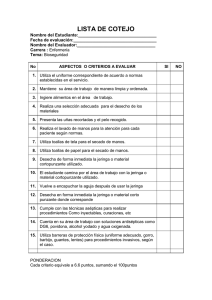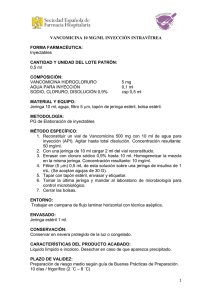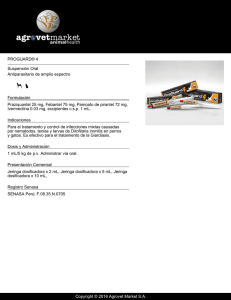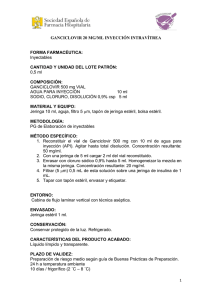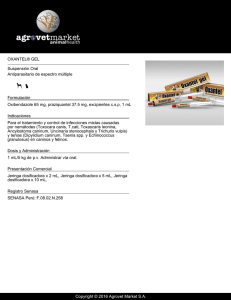Flushing the Line with Heparin, Saline or Citrate Cómo enjuagar la
Anuncio
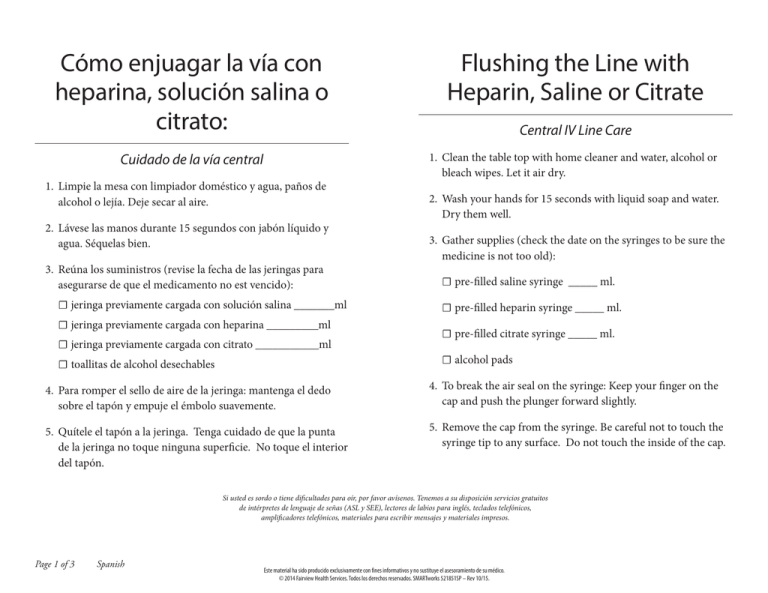
Cómo enjuagar la vía con heparina, solución salina o citrato: Flushing the Line with Heparin, Saline or Citrate Cuidado de la vía central 1. Clean the table top with home cleaner and water, alcohol or bleach wipes. Let it air dry. 1. Limpie la mesa con limpiador doméstico y agua, paños de alcohol o lejía. Deje secar al aire. 2. Lávese las manos durante 15 segundos con jabón líquido y agua. Séquelas bien. 3. Reúna los suministros (revise la fecha de las jeringas para asegurarse de que el medicamento no est vencido): ☐☐ jeringa previamente cargada con solución salina _______ml ☐☐ jeringa previamente cargada con heparina _________ml ☐☐ jeringa previamente cargada con citrato ___________ml ☐☐toallitas de alcohol desechables Central IV Line Care 2. Wash your hands for 15 seconds with liquid soap and water. Dry them well. 3. Gather supplies (check the date on the syringes to be sure the medicine is not too old): ☐☐pre-filled saline syringe _____ ml. ☐☐pre-filled heparin syringe _____ ml. ☐☐pre-filled citrate syringe _____ ml. ☐☐alcohol pads 4. Para romper el sello de aire de la jeringa: mantenga el dedo sobre el tapón y empuje el émbolo suavemente. 4. To break the air seal on the syringe: Keep your finger on the cap and push the plunger forward slightly. 5. Quítele el tapón a la jeringa. Tenga cuidado de que la punta de la jeringa no toque ninguna superficie. No toque el interior del tapón. 5. Remove the cap from the syringe. Be careful not to touch the syringe tip to any surface. Do not touch the inside of the cap. Si usted es sordo o tiene dificultades para oír, por favor avísenos. Tenemos a su disposición servicios gratuitos de intérpretes de lenguaje de señas (ASL y SEE), lectores de labios para inglés, teclados telefónicos, amplificadores telefónicos, materiales para escribir mensajes y materiales impresos. Page 1 of 3 Spanish Este material ha sido producido exclusivamente con fines informativos y no sustituye el asesoramiento de su médico. © 2014 Fairview Health Services. Todos los derechos reservados. SMARTworks 521851SP – Rev 10/15. 6. Con la punta de la jeringa hacia arriba golpee suavemente el lado de la jeringa para que las burbujas suban hasta la parte superior. 7. Empuje el émbolo hasta que aparezca una gota de líquido en la punta de la jeringa. 8. Verifique que tenga la cantidad correcta de heparina, solución salina o citrato en la jeringa. 9. Vuelva a poner el tapón en la jeringa. 10.Frote el tapón del extremo de la vía IV con una almohadilla con alcohol durante 15 segundos. Déjela secar al aire por 15 segundos. No abanique ni sople sobre el área. 11.Quite el tapón de la jeringa y gire la jeringa para atornillarla en el tapón del extremo de la vía. 12.Si hay una abrazadera en la vía, ábrala. 13.Enjuague la vía con un movimiento de empujar-pausa, empujar-pausa hasta que la jeringa esté vacía. Cierre la abrazadera si tiene una. 14.Sostenga el tapón del extremo y desatornille la jeringa (con cuidado de no quitar el tapón del extremo). Deseche la jeringa en la basura. 15.Asegúrese de que el tapón del extremo esté bien atornillado pero NO demasiado ajustado. 16.Si usted tiene una segunda línea, repita los pasos 4 a 15. Page 2 of 3 Spanish 6. Point syringe tip up and tap the side of syringe to move the bubbles to the top. 7. Push in the plunger until a drop of liquid appears at the tip of the syringe. 8. Check to see that you have the correct amount of heparin, saline or citrate in the syringe. 9. Put the cap back on the syringe. 10.Scrub the end cap on the IV line with an alcohol pad for 15 seconds. Let it air dry for 15 seconds. Do not fan or blow on the area. 11.Take the cap off the syringe, and twist syringe into the end cap of the line. 12.If there is a clamp on the line, open it. 13.Flush the line using a push-pause, push-pause motion until the syringe is empty. Close the clamp if you have one. 14.Hold the end cap and twist off the syringe (be careful not to remove the end cap). Throw the syringe away in the trash. 15.Make sure the end cap is screwed on tight, but NOT too tight. 16.If you have a second line, repeat steps 4 to 15. Cuándo enjuagar su vía Debe enjuagarla después de cada infusión o según se lo indique su enfermero. Cuando no esté usando la vía para medicamentos IV, enjuáguela cada _________________________________. ¿Problemas? When to flush your line You should flush after every infusion or as often as your nurse says. When not using the line for IV medicines, flush it every ___________________. Problems? Si el medicamento no se puede empujar con facilidad, asegúrese de que la abrazadera esté abierta. No ejerza fuerza. If the medicine cannot be pushed in with ease: Make sure the clamp is open. Do not force it. Si la vía tiene una pérdida: Use una abrazadera de emergencia para cerrar la vía por encima de la pérdida. Luego llame para obtener ayuda. If the line has a leak: Use an emergency clamp to clamp the line above the leak. Then call for help. Si tiene algún problema, llame: _______________________. Solo personas capacitadas por un enfermero deben enjuagar una vía IV. Mantenga los suministros fuera del alcance de los niños. Page 3 of 3 Spanish If you have any problems, please call:____________________ Only persons trained by a nurse should flush the IV line. Keep supplies away from children.
